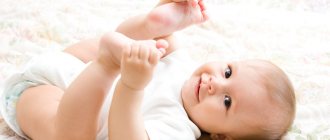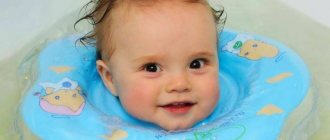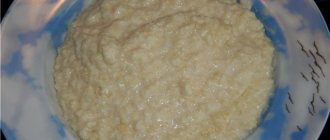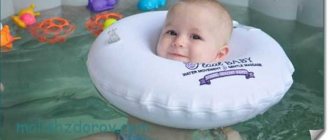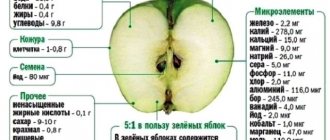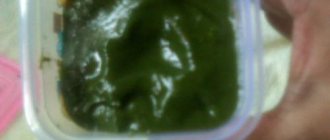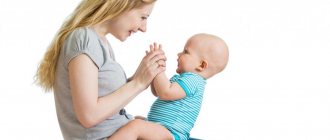Many future parents, seeing scratches for newborns in a catalog, do not immediately understand what they are. Today we will tell you in detail about these special mittens and give some tips on when to wear them and how to choose the right one.
In the Sarita catalog you can choose a complete set of things for a baby who has just been born. This is a serious moment, because from the first days of life a child needs clothes and even accessories! Including anti-scratch products for newborns, which we will talk about later. It is recommended to choose a set of clothes in advance, even before birth. Why?
The fact is that the expectant mother will have to study the list of necessary things, which includes not only undershirts, but also many other items of clothing. Children born in winter will need even more things on the first day after discharge. Often, in a hurry, parents forget to buy accessories - hats and bonnets, socks and booties, mittens and baby scratchers.
So that you don’t get confused and add everything you need to your order, we have created a separate section for newborns in the catalog. Go through each category so you don't forget important things.
Some parents believe that anti-scratch mittens are not necessarily needed for every child. However, we still recommend giving your child this soft and gentle protection.
How to sew scratchy mittens with your own hands?
Now you can buy anything in the store. The abundance of products for babies is simply amazing. But it’s much more pleasant to prepare some of the dowry yourself. Sewing scratchy mittens is not difficult even for those who are not very familiar with needlework.
Stage 1. Build a pattern
You need to create a pattern on paper. Don't be afraid. It's extremely simple.
- To do this, take a regular sheet of paper. A newspaper or magazine will do, as well as whatever you have on hand.
- We measure a 10 cm segment with a ruler and draw a horizontal line.
- Then we find the middle of the segment and measure 15 cm vertically, draw a vertical line.
- We draw two more vertical lines along the edges of the ten-centimeter segment.
- From the top of a vertical segment of 15 cm, you need to draw a semicircle.
The end result should be a pattern like this.
Stage 2. Select fabric and trim
A soft cotton fabric is suitable for sewing. You can sew scratches from flannel or thin cotton knitwear.
For decoration, you can use small bows made of thin satin ribbon. If you want to use lace, you need to make sure that it is not too stiff.
Also, to make scratches you will need a piece of regular elastic (it is better to choose a thinner one).
Stage 3. Transfer the pattern to the fabric
- Fold the prepared fabric in half and apply the pattern so that the fold of the fabric and the side edge of the pattern coincide.
- We outline the outline of the pattern with a pencil.
- Then carefully cut out the scratch blank along the contour.
- We do all the manipulations again, since you need two mittens.
You should end up with two pieces like this.
Stage 4. Sew on the elastic
An elastic band must be sewn to each workpiece.
We stretch the elastic band flush with the bottom edge of the workpiece and pin it with pins.
- To do this, measure a piece of elastic so that it is slightly shorter than the bottom edge of the workpiece.
- Fold the edge with the elastic about 1-2 cm.
- Machine sew the folded edge with elastic. You can do this without removing the pins.
- Once the stitching is done, you can remove the pins.
- We do the same with the second mitten.
The result will be something like this.
Stage 5. Processing the edge
- Fold the workpiece in half from the wrong side and process the free edge using an overlocker. We do not grab the fold area.
- If you don’t have an overlocker, you can sew the free edge on a machine and finish the edges with a zigzag stitch or by hand.
- Don't forget about the second mitten and also process the edges.
The end result is a mitten like this.
Stage 6. Decor
We turn the mittens right side out and sew bows, roses, and beads to the wrist.
Anything. But let's not get carried away. We remember that an abundance of decor will not be beneficial.
These scratches are suitable for home use and warm summer walks.
Mothers who are fond of handicrafts can knit scratchies for their baby from warm cotton yarn. Then they can be used as mittens for walking in cool weather. The pattern for knitted scratches is the same as for sewn ones.
These scratches are perfect for a girl. By slightly changing the decor and color of the yarn, you can make an option for a boy. For boys, small bear cubs or the sun are suitable as decorations, and the decoration can be done in blue.
Such mittens will not only be a useful functional item, but also a decoration for a little princess or gentleman. In addition, things made with love by your own hands will be better than any purchased product, even the highest quality. Detailed instructions for making knitted scratches with your own hands are in this video.
Pros and cons of scratches (mittens)
Pros and cons of scratches. Are they necessary? Scratchies are an accessory for a newborn, with the help of which you can avoid several troubles that accompany the first months of a baby’s life. Whether they are needed or not is the decision of every parent, which should be made based only on their child. What are scratches for? It’s not hard to guess, because their “function” comes from the word – to scratch. First of all, they protect the child from his own hands. Funny, isn't it? Everyone knows that in the first months of life, the baby cannot control his movements; he waves his arms rather chaotically, on which thin but very sharp nails grow, which also need to be allowed to develop. Therefore, you cannot cut them “at the root” every day, and you won’t be able to, since they have a special shape that makes it impossible to completely trim the nail. In order to avoid unpleasant wounds and scratches, scratches were actually invented. Their second task is to protect the hands from irritation by the child’s saliva. Almost every baby loves to suck their fingers and fists, and sometimes by overdoing it, children provoke skin irritations. In order to prevent such situations and infection, parents wear scratch covers. They reliably protect the skin of the little one. And when are they redundant? Not all children need this accessory. There are babies who don’t scratch themselves at all, and don’t feel the need to enjoy the taste of their fists. In such cases, you shouldn’t put scratches on your child again, because they don’t always help the baby. Everyone knows that newborns learn about the world with their hands, and the stage of sucking fingers, or waving their arms, is also development, and scratches, if they are worn every time the baby tries to get to know himself, will interfere with the baby. Until what age should you wear scratchies? This question is very individual. Many children refuse them at the age of 2-3 months, because at this time they are actively learning about the environment - the baby learns to grab toys and strives to grab any object that comes his way. You shouldn’t disrupt the development of your child’s tactile sensations; if you see that scratches are starting to bother your child, feel free to give them up. Still, this is not an obligatory attribute of a baby’s life, it is to some extent a simplification of the difficulties of the first months, and then learn to do without them. Is there an alternative? Also, there is a modern alternative to scratches - children's clothing with closed handles. Most bodysuits, little men and vests in sizes 56-62 are presented in our store with closed palms, which greatly simplifies the choice for parents. After all, you don’t have to buy scratches separately; you can buy an already combined item. You can purchase scratches in our online store - Thank you for being with us. With love, Minikin team.
How to properly dress a newborn?
A newly born baby should be dressed exclusively in natural materials, which include mainly “breathable” cotton and flannel fabrics, as well as lightweight knitwear.
Synthetics are strictly contraindicated: in the summer the baby sweats, and in the winter he freezes!
At home, one or two vests, rompers or light overalls are enough. If your baby's arms and legs are cold, he should wear sleeves and socks.
As for a hat, cap or scarf on a newborn’s head, there is no clear answer to this question either among “experienced” mothers and grandmothers, or experienced pediatricians.
There are two completely opposite opinions: some assert with complete confidence that a cap at home is mandatory even in hot weather, others believe that a cap should be worn depending on the situation - when going out onto the balcony or, in extreme cases, after taking a bath, and then only for 20-30 minutes, until your head dries out.
Types of caps for newborns
Hats for babies should be soft, light colors, made of natural fabrics, preferably cotton. In such hats, children do not get hot or cold, they do not sweat, and the delicate skin of the back of the head does not become irritated or subject to diaper rash.
Modern stores offer a huge variety of caps for newborns, differing in color, shape and design.
Smart cap
When choosing hats for babies, you need to take into account the following features:
- the cap should be soft, hygroscopic, allow air to pass through well, not tightly fit the baby’s head and at the same time not bunch up;
- when purchasing caps, you should focus not so much on the age parameters indicated by the manufacturer on the label, but on the size of the head of the newborn itself;
- It is advisable to avoid bright hats, with various pictures or ornaments, since fabrics with pictures can cause allergies in the baby.
The best choice is a plain cotton cap with wide and soft ribbons.
How to dress a baby in the maternity hospital
A newborn will need his first clothes in the maternity hospital, and it is better to start shopping after the 25th week of pregnancy. It is recommended to pack your belongings in bags, as most maternity hospitals do not allow travel bags. Label each package with a bright marker, indicating what and how much it contains.
All packages must be shown to your husband or one of your close relatives. Tell them exactly what will need to be brought before and after the birth, and what will be needed for discharge. Excited about the arrival of a baby, mothers often strive to purchase absolutely everything that is designed for newborn babies. When planning how much clothing a newborn needs in the maternity hospital, it is enough to include these things in the list:
- Diapers. To the maternity hospital you will need to take one pack of the smallest diapers (for children up to 4 kg). In case the baby is born large, buy a few more, but in a larger size (up to 6 kg). It is enough to take only a couple of pieces to the delivery room. The rest of the pack is taken to the ward where you will remain until discharge.
- Bike and calico diapers. Even if you don't plan to swaddle your baby, it's still worth bringing a few swaddles with you. They can be used as bedding.
- Sliders. You will need to take two pairs of sliders to the delivery room. Take a few more sets to your room. Usually mothers take 2 pairs for each day. You can buy it with a wide elastic band or with clasps on the shoulders. It is better to purchase both models at once, so you can later understand which clothes are more comfortable.
- Vests are taken at the rate of using one per day. Prepare one for the delivery room, four for the ward. This is the minimum quantity, and how many pieces you will take is up to you to decide.
- Blouses with buttons. For the maternity hospital, it is enough to take three pieces.
- "Little men." This clothing is very comfortable for cool periods. For the first time, two pieces will be enough for you. If you take baby vests and onesies to the maternity hospital, the “men” will not be useful to you.
- Socks. Newborns have not yet developed thermoregulation, so their feet are always cold. You should definitely take several pairs of socks to the maternity hospital: one for the delivery room, two more for the ward.
- Hats. Take three pieces to the maternity hospital. One of them will be useful in the delivery room, two - in the ward.
- Blanket. When choosing material, consider the time of year. The blanket should be warm enough for the baby.
- Scratches. They are put on the hands of a newborn so that he does not accidentally injure himself.
Is the baby cold or hot?
An inexperienced mother should know the basic rules for determining temperature for a small family member:
You should never rely on a thermometer that shows the temperature of a room or street, and even more so, on your own sensations and well-being. What needs to be taken into account is not the condition of the baby’s fingertips or nose, but the area of the feet, upper back, folds of the neck and crown. The main indicator is humidity (the child is hot and sweating) or, conversely, the coolness of certain parts of the body (the baby is cold). If in the first case it is necessary to change the baby into lighter clothes, then in the second, of course, you need to dress the baby warmer.. The best room temperature for a baby is 25-27 degrees Celsius.
The best room temperature for a baby is 25-27 degrees Celsius.
Scratch mittens for newborns
When your long-awaited baby is already born, he needs even more attention and care. So, for example, during sleep or play, a baby, due to its temporary poor coordination of movements, can walk its nails on its own thin skin, resulting in scratches and wounds through which bacteria can easily enter the newly formed body.
To avoid this, special “scratch” mittens, or, as they are also called, “anti-scratch” mittens, began to be produced, which are most often sewn from knitwear on a completely cotton base. This useful attribute is placed on the handles, where it is held in place by a non-pressing elastic band or ties.
Scratchies for newborns
Scratchies for newborns are an accessory that can help you avoid a number of troubles. They are small covers that are placed on the little ones' hands. Most often, they are held on the wrist thanks to a loose elastic band or fabric ties. Based on the name, scratches are necessary to protect the baby from his still naughty hands. Fabric mittens reliably protect his face from scratches.
It is no secret that many newborns are capable of injuring themselves with sharp nails, because the coordination of hand movements is still imperfect, and it is time to learn about the world around them and themselves. Trimming nails sometimes does not help, because in most children the nail plate protrudes slightly, that is, it is simply impossible to cut it “at the root.” And a tenth of a millimeter is enough for the baby to hurt himself by scratching his face.
Another purpose of this accessory for newborns is to protect hands from sucking. This reflex is more developed in infants than others, so fingers and even fists often end up in the mouth. Some babies get so carried away by the process that irritation appears on their hands, and this is a direct path to infection in the wound.
It is impossible to say exactly at what age a baby should be dressed for scratches. Some babies, after a couple of days of wearing them, no longer try to scratch their faces, others “fight” with their hands for two to three months. Each mother herself understands when it is time for her baby to remove scratches, but it is recommended to do this as early as possible. And that's why.
Tactile sensations play a huge role in exploring such a new and huge world around us. At the age of two or three months, the child is already interested in toys, tries to hold them in his hand, touch and examine them. But it is quite difficult to do this with scratches. In addition, the hands in them can sweat, which also cannot be called beneficial for the baby.
If you don’t know at what age scratches are needed, it’s better to stop using them until your baby is at least three months old. Are you afraid of new marks of marigolds on his face? Then wear them only at night. To do this, it is more convenient to use bodysuits with scratches for newborns, which, if necessary, can be unscrewed in the form of a cuff. During the day, monitor your baby’s hands, because in any case, you are nearby most of the day.
When choosing a dowry for a newborn, a crib, mattress and bed linen, it is important not to forget about their sizes. Most often, parents focus on the size of the crib itself in order to make purchases based on them
Our article is about the sizes of cribs.
Transformable overalls for newborns The question of choosing winter clothes for a newborn is quite difficult, because the baby practically does not move during walks, and his thermoregulation is not yet perfect. To ensure that parents do not worry about the baby freezing, manufacturers offer many models of transformable overalls.
Transformable stroller 3 in 1 When compiling a dowry list for a newborn, young parents are sometimes surprised to learn that the baby requires not one stroller, but at least two, or even all three. But maybe they can be replaced with 3-in-1 transformable strollers?
If you live in a snowy region and are lucky enough to become parents in the winter, you may encounter the problem that pushing a stroller through the snow is very inconvenient. However, there are special sleds for babies on sale.
How long should I wear scratches?
It is very important to promptly and fully protect children's skin from damage. But this does not mean that nursery mittens need to be worn all your life. It only takes a few weeks after birth for a baby to learn to control his body movements. In addition to the main function, the accessory performs several additional functions:
- Helps warm the baby's hands while walking. Infants have imperfect thermoregulation in the first months of life. Often, heat transfer exceeds heat production, so to prevent little fingers from freezing, it is better to wear nursery mittens. The baby will feel comfortable, will be able to quickly fall asleep and rest peacefully.
- Wean your child off fist sucking. The sucking reflex in babies is innate. This often leads to the fact that he pulls everything he comes across into his mouth. First of all, your own fingers and fists “suffer”. But this threatens the appearance of infections in the mouth and malocclusion in the future, so it is important to promptly wean the baby from sucking fingers and fists. Those same scratches will help do this.
Nursery mittens, which are used primarily to protect baby's skin from scratches, have several advantages:
- Easy to put on. Stretchy elastic band and a simple cut make the mittens easy to put on.
- Hypoallergenic. The product is made of material that gives a pleasant tactile sensation and does not cause any adverse reactions.
- Comfortable. For babies, wearing fabric mittens in the first months of life does not cause discomfort.
- Stylish. Manufacturers produce scratches with different decors. Therefore, mothers can, if desired, choose an option for each baby’s outfit.
- Do not pinch the handle. An elastic band secures the mitten on the hand, but does not squeeze it and does not interfere with blood circulation.
Despite all the benefits of scratchies, pediatricians do not recommend wearing them for too long. The baby must gradually master his own body and learn to coordinate it. Nursery mittens can limit a baby’s ability to explore the world around them, because they don’t allow you to move your fingers much or take anything in your hands.
Parents should understand that tactile sensations play a huge role in the development of the baby. The baby begins to be interested in toys, touch them, and try to pick them up at 2-3 months. Therefore, at this age you can already get rid of such an accessory for little girls and boys as nursery mittens.
Wearing scratches for too long threatens that the child will begin to lag behind in development. It will take a long time to make up for lost time, so it is better to prevent such a situation.
The time when it is time to remove scratches can be determined by the baby's behavior. If he shows interest in the world around him, coordinates his movements normally and does not pull his fingers with sharp nails towards his face, the scratches can be removed. In the future, they can be removed during the day and put on only during sleep.
When wearing a piece of clothing such as nursery mittens, pay attention to your baby's hands. If they sweat and their skin becomes hot, wearing this children's accessory should be stopped immediately.
Arguments against the bonnet
Firstly, only a born person has practically the same rights as other family members. If a healthy adult would never think of wearing a hat at home, then for what reason does a newborn need to cover his head?
Knitted cap
Secondly, the less you wrap a child, the healthier he will grow. Inside the rooms, the air temperature is never changeable, and the cap, in turn, fitting tightly to the head, creates a kind of greenhouse effect, causing only harm to the newborn baby and preventing the baby’s delicate skin from breathing.
Whatever the parents’ decision on the issue of whether to put on a newborn cap (cap, scarf), you should always remember the advice of the famous pediatrician Komarovsky that the baby’s skin should breathe.
Advantages and disadvantages of putting a cap on a newborn at home
- a sweat patch appears on the lower part of the back of the head;
- excessive wrapping leads to a natural result - frequent colds, you just need to blow a little breeze;
- the complete lack of hardening of the child is a counterbalance to a healthy lifestyle.
A newborn's constantly exposed head can cause:
- diseases of the middle ear or the development of meningitis;
- bending of one of the ears, since the baby may involuntarily lie on the ear during sleep.
What happens in practice?
Most young mothers start from a specific situation and adapt to the circumstances: they put on a cap after bathing, ventilating the children's room, when the heating is turned off, and also if the room temperature drops below 20 degrees Celsius, etc.
There are no compromises in the issue of putting caps on the head of a newborn: the older generation - grandmothers and mothers-in-law - are ardent supporters of wearing a cap at home up to one year old, modern pediatricians and new mothers believe that overheating is much dangerous for the baby’s health.
The newborn should have the same number of layers of clothing as the mother + one more.
Expert commentary
Very often we can hear from grandmothers “immediately put scratches on your child!”, “If you don’t hide the hands, he will pull them into his mouth and get hurt,” “Without scratches, the child will learn to constantly suck his finger” - and many other “reasonable” recommendations. In fact, we can put all these judgments in grandma's chest along with a lot of prejudices.
Why is it so important for babies to keep their hands open? It is very important for a child to get to know his body after birth. After all, he spent 9 months inside his mother and after birth he does not understand that now he is outside. How can he understand that he has fingers, arms and legs? Elementary! Until the child takes them into his mouth without feeling them with his lips and tongue, or until he touches his face, arm and legs with his fingers. As long as the child’s hand is scratched, he cannot make full hand-mouth contact. When scratched, he also cannot feel his fingers. As a result, the baby feels nothing and understands nothing. By wearing scratches, you delay the child’s natural mechanism of self-knowledge.
What skills can be delayed by scratching? The baby is born in a state of physiological hypertonicity, with clenched arms. If the hands are constantly limited to scratching, how will the baby be able to relax and get out of this state on his own? Scratching delays the baby's release from physiological hypertonicity. Also, scratching can affect such an important process as holding the head, and pediatricians and neurologists pay very careful attention to this point. When you turn your baby over on his stomach and his hands are scratched, he has no idea what to do with his hands. Because, in order to form a physiological reaction of straightening with raising the head, he needs to lean on an open palm and make contact with the surface. But how will he do this, being scratched? Conclusion Undoubtedly, scratches can be a necessary element and they may not protect the baby from being scratched for long. But they do much more harm than good. So quickly free your baby's hands from scratches. Free your hands!
Need some advice?
To make an appointment with a doctor
Callback form
Application has been sent, we will contact you soon
Is it useful or not?
Determining at what age a child needs this product is not easy. Some people stop scratching themselves after just a few days, while others continue to use their nails for another three months.
Each case is individual. You yourself must understand when to remove scratches. But we recommend not to delay wearing them. Newborns begin to explore the world around them by touching different objects. They pick up toys and various things that lie nearby, which is almost impossible to do with such “gloves.”
Another disadvantage of wearing the product for a long time is that the baby’s hands will sweat, and this can negatively affect health.
If you are afraid that your baby will not be able to explore the world through touch, we recommend that you stop wearing scratchers after three months.
If your child still scratches himself, then wear the products only at night, and keep an eye on him during the day.
On Vikids you can:
Principle of operation
Babies' nails grow constantly. There is no point in trimming them - in any case, a small nail will remain, which can still harm the child.
Even if a quarter of a millimeter remains, the child can cripple the skin - at this age it is still very thin and delicate. With the help of scratches, your nails will always be covered, and your face will be safe.
This product is also needed to prevent the baby from sucking his thumb. At this age, this reflex is very developed, and microbes are constantly in the child’s mouth, which can negatively affect health.
Is it useful or not?
Determining at what age a child needs this product is not easy. Some people stop scratching themselves after just a few days, while others continue to use their nails for another three months.
Each case is individual. You yourself must understand when to remove scratches. But we recommend not to delay wearing them. Newborns begin to explore the world around them by touching different objects. They pick up toys and various things that lie nearby, which is almost impossible to do with such “gloves.”
Another disadvantage of wearing the product for a long time is that the baby’s hands will sweat, and this can negatively affect health.
If you are afraid that your baby will not be able to explore the world through touch, we recommend that you stop wearing scratchers after three months.
If your child still scratches himself, then wear the products only at night, and keep an eye on him during the day.
On Vikids you can:
When your long-awaited baby is already born, he needs even more attention and care. So, for example, during sleep or play, a baby, due to its temporary poor coordination of movements, can walk its nails on its own thin skin, resulting in scratches and wounds through which bacteria can easily enter the newly formed body.
To avoid this, special “scratch” mittens, or, as they are also called, “anti-scratch” mittens, began to be produced, which are most often sewn from knitwear on a completely cotton base. This useful attribute is placed on the handles, where it is held in place by a non-pressing elastic band or ties.
Negative consequences
If parents do not know how to wear a collar for a newborn and self-medicate, complications may arise for the child. These include the following conditions:
- if the collar is over-tensioned, it begins to compress the neck and trachea area, leading to breathing problems. As a result, the child begins to experience hypoxia and the functioning of the cardiovascular system changes;
- With prolonged use of the splint, hypotrophy or atrophy of the neck muscles occurs. In the absence of load, their volume decreases, which can lead to the progression of the underlying disease. At the age of two months, children can hold their heads well and the collar should only be used for a short time.
The use of homemade devices is prohibited. Tires must be manufactured in accordance with existing standards and from materials approved for use for newborns.
The Shants collar for newborns is an important part of the treatment of congenital neck pathologies. It allows you to fix it in a physiological position and prevent the further development of diseases
In therapy using a splint, it is important to choose the right one in consultation with an orthopedist. The doctor will choose the size of the collar, explain how to put it on, and describe a wearing pattern during the first weeks of treatment
If the child is constantly restless or there are external signs of soft tissue compression by the splint, parents should immediately consult a doctor.
Grandmother's advice - is it worth listening to? #2 Scratches, caps, etc.
Scratchies, caps, socks, hats... You can’t go anywhere without them. Until now, I come to calls and in 95% of cases I see children in caps, socks and scratches in houses and apartments. But what about it? After all, everyone is smart and knows that maximum heat loss occurs through the head. Feet need to be kept warm. And the scratches... the child scratches himself, there’s already a wound near his eye, and he’ll scratch out his eye...
And every time I say that a child produces an incredible amount of heat if he is allowed to move. His metabolic processes are many times faster than ours, and when the average mother begins to feel cold, her baby is fine!
Indeed, a lot of heat goes through the head, but it is EXCESSIVE heat. This is how the baby protects itself from overheating. I'm not talking about cases of prematurity, when the mechanisms of thermoregulation are far from mature, and the baby cannot maintain his own body temperature constantly.
It is especially important to be at home without a hat when the baby is dressed very warmly. It’s very warm - at 22 degrees without drafts, the child is wearing a cotton man, a velor jacket, warm socks and a fleece overall. It’s better, of course, to undress such a baby, but at least take off the cap.
All MiBs have a fear of hypothermia in the baby. But, unfortunately, they do not know that it is easier to overheat a full-term mature healthy baby than to overcool it. Overheating is much worse, because the sweating mechanism is not yet working at full capacity, and it is more difficult for the baby to cool himself down.
And if excess heat has accumulated, it is necessary to give it the opportunity to escape - to free the main gate - the baby's head. Scratching seems to solve the problem of self-injury. But often just cutting your baby’s nails is enough! Many mothers, especially those with their first child, or children with a large age difference, are afraid to cut such tiny thin nails on tiny fingers, and then I show them that it’s not scary, that you just need to take your time.
Scratches, in fact, appear from the mother’s lack of self-confidence, from insufficient awareness of the fact that this child is now her area and only her responsibility. Dressing scratches and not cutting off nails, mothers themselves do not even know what they are waiting for. They simply put off solving the problem until later, but they will have to solve it anyway.
So don't be afraid. Yes, the experience is new and unusual, but you can do it! Even if (suddenly!) you cut your baby's skin a little, just treat it with hydrogen peroxide and kiss it. This is not a trauma that will leave an indelible mark on the child’s soul or bring him physical torment. He may not even realize what and where he suddenly felt a pain and stopped. Be brave! And then your hand will not tremble!
